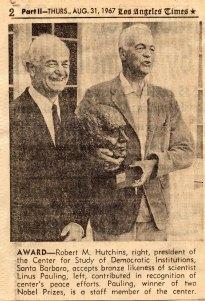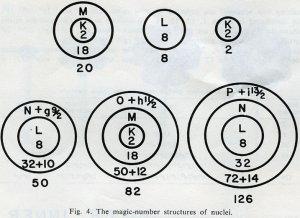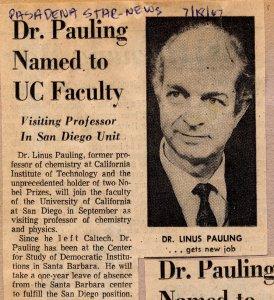
[Part 6 of 6 in a series examining Pauling’s association with the Center for the Study of Democratic Institutions]
One of Linus Pauling’s hopes during his time at the Center for the Study of Democratic Institutions (CSDI) was to collaborate with neighboring institutions, such as branches of the University of California, and perform scientific research while contributing to the Center’s discussions on world peace. Pauling joined the Center because he believed that science should be used to address social issues and to offer solutions to the problems facing society. Pauling was optimistic of the support and independence that he would enjoy at the Center in support of his ambitions. Upon their arrival to Santa Barbara, however, Ava Helen Pauling expressed the fear that her husband might find the CSDI “too superficial.”
Ava Helen’s prediction, as it turned out, was basically correct, and more and more her husband found himself disappointed by his inability to progress his scientific research. Originally he had hoped to use the scientific method to tackle world affairs but, as he soon realized, the Center preferred to focus on appeals to the public rather than programs of research. His options for joining neighboring institutions to perform scientific work were also quite limited. Importantly, the University of California rejected Pauling’s application for an adjunct position at UC Santa Barbara because of his controversial politics. By August 1965, only two years after being hired by the CSDI and just one year after moving to Santa Barbara, Pauling was writing letters to the Center’s president, Robert Hutchins, asking to spend less time at CSDI headquarters so that he might advance his scientific work from a new base – the Pauling ranch at Big Sur.

Figure from “The close-packed-spheron theory and nuclear fission,” Science, October 1965.
Pauling spent much of his time away from Santa Barbara developing a new model of the atom, which he called the close-packed-spheron model of atomic nuclei. This theory of nuclear structure was published in four different articles (“Structural significance of the principal quantum number of nucleonic orbital wave functions,” Phys. Rev. Lett., September 1965; “Structural basis of neutron and proton magic numbers in atomic nuclei,” Nature, October 1965; “The close-packed-spheron model of atomic nuclei and its relation to the shell model,” Proc. Natl. Acad. Sci., October 1965; and “The close-packed-spheron theory and nuclear fission,” Science, October 1965) each of which addressed different implications of the theory.
Pauling’s work dealt with “magic numbers” and nuclear subshells. Previously it was known that magic numbers describe the quantity of protons and neutrons that make an atom particularly stable. Pauling’s theory, however, suggests that the “magic” qualities associated with these numbers of nuclear components corresponds to the filling of nuclear “spherons,” or nuclear sub-units where protons and neutrons are arranged. (These spherons or sub-units were also referred to as shells in previous theories.) The close-packed theory therefore suggests that nuclear components form clusters rather than arranging as independent particles.
The close-packed-spheron model was based on the earlier nuclear shell theory. Pauling took the nuclear shell theory a step further by attempting to explain why specific numbers of protons and neutrons cause greater nuclear stability. The close-packed-spheron model states that the lower magic numbers represent atoms in which the first or second nuclear shells are filled, and that higher magic numbers correspond to a special “mantle” shell; that is, a hybridized shell that can form if greater amounts of nuclear components arrange into spheres.
In developing his model, Pauling was trying to explain the arrangement of nuclear components by simplifying previous theories and applying the principles of electron orbitals to protons and neutrons in the atomic nucleus. Pauling’s past work had helped to establish the principles of electron orbital hybridization, and he hoped that this new work would yield similar fruit for the atomic nucleus. If such were the case, it would then be possible to explain the stability of atoms with magic numbers and the geometric arrangement of protons and neutrons.
Pauling’s close-packed theory was interesting and relatively simple; however, it failed to spark interest among many other scientists. For the next several years, Pauling continued to advocate for the theory and, in June 1974, he applied for a National Science Foundation grant to support further theoretical research on the structure of atomic nuclei. The application was denied and Pauling turned his attentions elsewhere.

The development of the close-packed-spheron theory and the lack of attention that it received from the scientific community are emblematic of the difficulties that Pauling experienced during his affiliation with the CSDI. The limited resources available to Pauling during this time enabled only theoretical investigations on subjects with which he was already at least somewhat familiar. And his official connection with an institution that existed well out of the scientific mainstream stifled his ability to engage with his scientific peers on a regular basis.
Pauling was only at the CSDI until 1967, and towards the end of his tenure there his eagerness to return to the sciences only grew. Other publications from the period focused on molecular protein structure and the chemical bond. As with the structure of atomic nuclei, these topics were, again, among those that he had researched prior to moving to Santa Barbara. Once he found a new scientific home, the University of California at San Diego, Pauling began new investigations in medical chemistry which ultimately led to his famous fascination with vitamin C.
Pauling’s switch to a scientific focus could be interpreted as stemming from a waning interest in world affairs, but his papers show that it was the limitations that he encountered at the CSDI that led him to return to more scientific pursuits. World affairs remained central to Pauling’s activities and continued to lay claim to large pieces of his time, especially as the war in Vietnam escalated throughout the late 1960s and early 1970s. Pauling was interested in developing ideas that could lead the world towards peace, while the Center was primarily a think tank that often focused more on discussion rather than reaching conclusions. In the end, superficial or not, the CSDI simply was not the institution for Linus Pauling.
